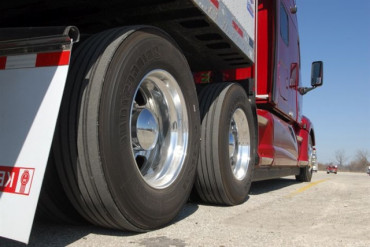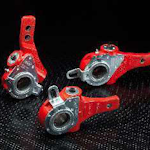What inspectors will be looking for during CVSA’s Brake Safety Week

The Commercial Vehicle Safety Alliance’s annual Brake Safety Week is scheduled for Sept. 15-22 with a focus on brake hoses and tubing, and if the results of June’s 72-hour International Roadcheck inspection blitz are any indicator, trouble lies ahead for many operators.
CVSA placed 12,019 trucks and 2,784 drivers out of service, accounting for a 17.9% vehicle OOS rate and a 4.2% driver OOS rate during the blitz. In total, inspectors across the U.S. and Canada conducted 67,072 inspections June 4-6. The top out of service violation for vehicles in June were braking systems, accounting for 4,578 out of service violations – or 28% of the total.
While it’s easy to hear a busted diaphragm inside a brake’s air chamber, checking chamber pushrod tolerances take more time and may warrant more work than first realized if out of adjustment. Other components could be to blame which can still take the truck out of service not long after an out of spec pushrod is allegedly fixed.
“When a brake adjustment is necessary and the unit is equipped with automatic slack adjusters it is important to determine the root cause rather than adjusting the slack adjuster,” says Matt Copot, vice president of maintenance at Transervice. “It’s possible that the slack adjuster is defective or that there is excessive wear within the camshaft, bushings, or clevis pin. Simply adjusting the brake will not prevent the brakes from going out of adjustment a short time later.”
Throughout the week in mid-September, inspectors will conduct roadside inspections, honing in on brake violations.
CVSA says brake hoses and tubing are essential for the proper operation of braking systems in trucks. Inspectors will be checking to make sure the hoses and tubing are properly attached, undamaged, without leaks and appropriately flexible.
Regular and thorough inspections will help prevent brake problems from leading to OOS violations.
“Brakes should be looked at for proper operation on a regular basis,” says Jim Lana, director of operations at Fleet Group. “Proper lubrication of the slack adjustors and S-Cam bushings will extend the life of the brakes and will ensure that you have the properly operating brakes. All brake components should be inspected for excessive wear and proper operation of the slack adjusters. Any wear in the S-cam bushings will effectively reduce the effective stroke of the slack adjuster resulting in reduced braking ability and tagged out of service.”
As part of pre- and post-trip inspections, drivers should check the slack adjuster for correct operation, lose or missing hardware, a missing cotter pin, bent or damaged components such as the control arm or attaching anchor brackets, and worn clevises, clevis pins and clevis pin bushings.
Joe Kay, director of brake engineering for Meritor, said fleets that run lightly loaded are more susceptible to vibration, which can accelerate brake stroke issues.
While it’s easy to see the correlation between thorough periodic maintenance and fewer OOS violations, some fleets continue to live on the edge.
“We all know how important a properly functioning brake system is to vehicle operation,” added CVSA President Chief Jay Thompson with the Arkansas Highway Police. “All components of the brake system must always be in proper operating condition. Brake systems and their parts and components must be routinely checked and carefully and consistently maintained to ensure the health and safety of the overall vehicle.”
Out-of-adjustment brakes and other brake system violations represented 45 percent of all out-of-service vehicle violations during 2018’s International Roadcheck. During last year’s Brake Safety Week, law enforcement conducted more than 35,000 inspections and placed nearly 5,000 of those out-of-service.
“Some fleets have excellent logistic and maintenance practices while others do not perform inspections until an issue arises,” says David Gonska, director of engineering at Stemco.
“Have any air leaks inspected by a professional technician, as air leaks can be a symptom of a much bigger problem,” Homer Hogg, director of technical service at TA/Petro, said. “When your air brake system is contaminated with oil, o-rings and seals inside brake valves will fail, and the truck will experience multiple valve failures over time. This can be costly in both repairs and downtime. The root cause of this issue could simply be a dirty air filter, which causes the air compressor to pass oil into the air brake system.”

Don’t slack off on slack adjustor inspection, maintenance
Properly lubricating the ASA purges old grease, water and contaminants from the adjuster and protects its internal gear sets, clutches and other components from wear.
Air leaks can quickly lead to an OOS violation as was the case for one of the trucks Florida Highway Patrol Trooper Bobby Simmons inspected recently in Jackson County, Fla. Another truck, Simmons examined, had a leak on top of an air tank and still another had an air line that was being worn away from friction as it lay across an axle without protective loom.
“The biggest thing that we see on air lines is going to be chafing,” Simmons said.
At Ryder, senior manager for national accounts technical support Art Trahan said since drivers easily spend more time with trucks than technicians, they should be thoroughly trained on how to best conduct pre and post-driving inspections. Trahan, who’s worked at Ryder for 42 years, has spent plenty of time training drivers for truck inspections.
“Most drivers struggle with the pre-trip,” Trahan said. “When you’re scoring someone that’s doing the pre-trip, they may look at something but if they don’t visualize it and if they don’t verbalize it, that’s a problem. If they don’t point it out to you—show me, touch it, pull on it, do something, talk to me—you can’t give them credit for it.
“When I teach how to do a good pre-trip, you over-verbalize it: try to explain to them what you’re looking for and why,” Trahan continued. “And there’s a turnover with drivers so you may have to do it more often than you like. Or you train a driver that would be a driver-trainer and then that driver-trainer can help train them. But if you just tell someone go do a pre-trip and you never trained them as to what a pre-trip and post-trip looks like, you’re not going to get very good results.”
